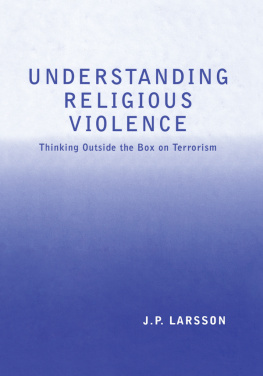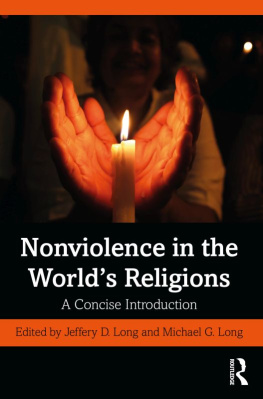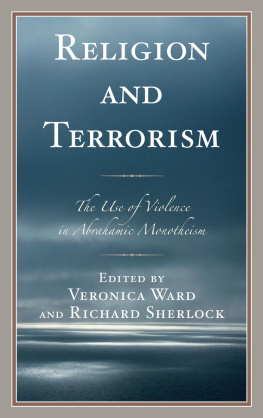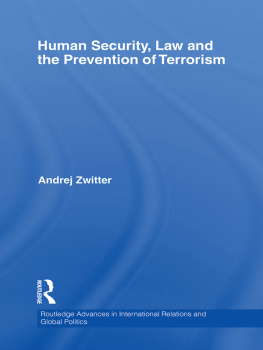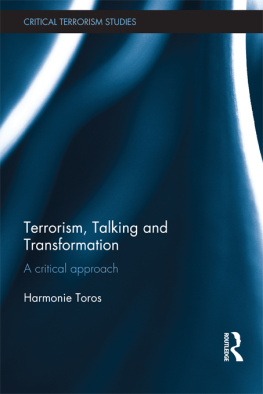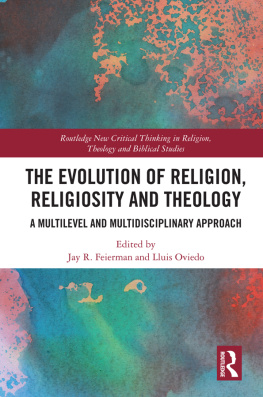First published 2004 by Ashgate Publishing
Published 2017 by Routledge
2 Park Square, Milton Park, Abingdon, Oxon OX14 4RN
711 Third Avenue, New York, NY 10017, USA
Routledge is an imprint of the Taylor & Francis Group, an informa business
Copyright J.P. Larsson 2004
J.P. Larsson has asserted his right under the Copyright, Designs and Patents Act, 1988, to be identified as the author of this work.
All rights reserved. No part of this book may be reprinted or reproduced or utilised in any form or by any electronic, mechanical, or other means, now known or hereafter invented, including photocopying and recording, or in any information storage or retrieval system, without permission in writing from the publishers.
Notice:
Product or corporate names may be trademarks or registered trademarks, and are used only for identification and explanation without intent to infringe.
British Library Cataloguing in Publication Data
Larsson, J. P.
Understanding religious violence: thinking outside the box
on terrorism
I. Violence Religious aspects 2. Terrorism Religious
aspects 3. War Religious aspects
I. Title
291.5697
Library of Congress Cataloging-in-Publication Data
Larsson, J.P., 1977
Understanding religious violence: thinking outside the box on terrorism / J.P. Larsson.
p. cm.
Includes bibliographical references and index.
ISBN 0-7546-3908-8
1. Violence--Religious aspects. I. Title.
BL65.V55L37 2004
201.7273--dc22 2003054486
ISBN 13: 978-0-7546-3908-4 (hbk)
In the Roman era, his temple was closed during peace and open in times of war. Today, when the doors of the Temple of Janus seem permanently wedged open, it is easy to become despairing of the present and disillusioned about the future. On an almost daily basis, the mass media are inundated with accounts of violence, terrorism, armed conflict and war. In most of these, religion seems to be a prevailing factor. The main reason for the amount and intensity of religious violence on the international arena is arguably because it is not properly understood, and is thus perpetuated. By taking my cue from British strategist Basil Henry Liddell-Hart, therefore, I argue in this book that in order to achieve peace it is necessary to understand war. By making this my explicit starting-point, I do not agree with such scholars who insist that when it comes to trying to understand war, only a fool or worse thinks he can find the truth.
It does not take an in-depth study to see that the contemporary world is plagued by violence, terrorism and armed conflict. More often than not, and for a variety of motives, religion is implicated in violent events, ranging from terrorism to territorial disputes. In order to make the world a less violent place, however, an in-depth analysis is necessary for dispelling the misperceptions underlying much of the religious violence of the world. This is not to say that all violence or terrorism has religious elements, or that religion should be removed from international politics (in fact, I refute both positions). Today, most attempts at explaining and describing the world suffer from one major defect, namely the lack of genuine understanding of the relationship between religion and violence. Therefore, this is a book about religious armed conflict.
It is the ultimate aim of this study to investigate the ontological roots of this defect, and to offer a useful framework for conflict transformation. This is done by progressively moving from the conventional view of religion and armed conflict (explanation) to a sound basis for understanding the logic and rationality of such conflict. It thus aims to show that not only is global religious violence a deeply rational and logical phenomenon, but also one which has previously not been thoroughly (or satisfactorily) investigated. A journey is therefore undertaken from explanation to understanding.
This journey would not have been possible without the research of other scholars of religious violence around the world. In particular I am grateful for the pioneering research and insights of Mark Juergensmeyer in the comparative study of religious violence in an era of globalisation. I am also grateful for his earlier work on Gandhian conflict resolution which I have utilized in my thinking about alternatives to religious violence. Too many scholars have influenced my own thinking to be individually acknowledged here, but I hope I have clearly attributed wherever and whenever I am in their debt, as this work uses such existing research that I hope will illuminate the logic of religious violence, relate it to contemporary thinking in the social sciences, and help to alleviate the causes of religious violence wherever it occurs.
With a bit of ingenuity, inventive thinking and certainly patience, I believe that we can overcome the forces of terrorism and religious violence that today plague the world. Any conflict can be overcome, no matter how intractable and inevitable it at first seems. It may involve making concessions we thought we were not willing to make, or it may merely involve altering our own perceptions through deeper knowledge. At times, what we thought we knew as fact may not be so, and new research and thinking may completely alter the face of the world. For example, rather than a roadmap to peace, which seems to imply that peace is a static goal that can be reached rather than a continuous relationship or state of being, an alternative angle like Ernest Martins research into the site of the temples at Jerusalem may be more beneficial, in line with the quest for understanding I advocate in this book.
Definitions, confessions and apologies
This book started its life as a PhD thesis, and in their present form, many of the arguments have thus been somewhat simplified from their original rigour. The same is true of the elaborate citations and research, much of which has been docked or severely modified. The research deals with several concepts and phenomena that are either not in popular usage or applied in a somewhat specific manner throughout this book. The readers tacit understanding of various concepts (such as religion) will be sufficient at the outset, and I will highlight particular usage along the way.
In line with the welcomed recent trend by some scholars to identify their personal position, it should be made clear that the roots of this book stem primarily from the Western philosophical tradition. It is the work of a reformed political scientist and an atheistic pacifist. As such, this book cannot be seen as condoning violence in any way, or endorsing any particular religious tradition. However, being a reformed political scientist also means that neither secularism nor religious politics are advocated. Like a bullet which has no sui generis alignment or cause, however, it can be used as a tool for killers, a weapon to be used by whoever wants to create damage. For this there is nothing but a pre-emptive apology, and an insistence that the understandings advocated herein are taken to heart.

